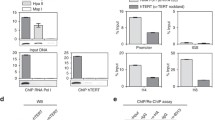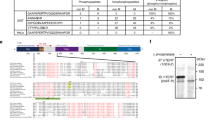Abstract
TTC4 (tetratricopeptide repeat domain protein 4) is a putative tumor suppressor involved in the transformation of melanocytes. At present, the relationships between TTC4 and DNA replication proteins are largely unknown, as are the tissue distribution and subcellular localization of TTC4. Using reverse transcription with the polymerase chain reaction, we have observed that the murine TTC4 gene is ubiquitously expressed. Analysis of the TTC4 subcellular localization has shown that, upon overexpression, TTC4 localizes to the cytoplasm. Interestingly, co-expression with a known protein interaction partner, hampin/MSL1, results in the nuclear translocation of the TTC4 protein. The subcellular localization of endogenous TTC4 depends, however, on the cell cycle: it is mostly nuclear in the G1 and S phases and is evenly distributed between the nucleus and cytoplasm in G2. The nuclear transport of TTC4 is apparently a complex process dependent on interactions with other proteins during the progression of the cell cycle. Thus, the dynamic character of the nuclear accumulation of TTC4 might be a potential link with regard to its function in tumor suppression.



Similar content being viewed by others
References
Blatch GL, Lässle M (1999) The tetratricopeptide repeat: a structural motif mediating protein-protein interactions. Bioessays 21:932–939
Borlado LR, Méndez J (2008) CDC6: from DNA replication to cell cycle checkpoints and oncogenesis. Carcinogenesis 29:237–243
Crevel G, Bates H, Huikeshoven H, Cotterill S (2001) The Drosophila Dpit47 protein is a nuclear Hsp90 co-chaperone that interacts with DNA polymerase alpha. J Cell Sci 114:2015–2025
Crevel G, Bennett D, Cotterill S (2008) The human TPR protein TTC4 is a putative Hsp90 co-chaperone which interacts with CDC6 and shows alterations in transformed cells. PLoS ONE 3:e0001737
Delmolino LM, Saha P, Dutta A (2001) Multiple mechanisms regulate subcellular localization of human CDC6. J Biol Chem 276:26947–26954
Dmitriev RI, Pestov NB, Korneenko TV, Gerasimova AV, Zhao H, Modianov NN, Kostina MB, Shakhparonov MI (2005) Tissue specificity of alternative splicing products of mouse mRNA encoding new protein hampin homologous to the Drosophila MSL-1 protein. Bioorg Khim 31:363–371
Dmitriev RI, Pestov NB, Korneenko TV, Shakhparonov MI (2006) Intracellular location of hampin isoforms. Dokl Biochem Biophys 408:130–132
Dmitriev RI, Korneenko TV, Bessonov AA, Shakhparonov MI, Modyanov NN, Pestov NB (2007) Characterization of hampin/MSL1 as a node in the nuclear interactome. Biochem Biophys Res Commun 355:1051–1057
Easwaran HP, Leonhardt H, Cardoso MC (2005) Cell cycle markers for live cell analyses. Cell Cycle 4:453–455
Fabbro M, Henderson BR (2003) Regulation of tumor suppressors by nuclear-cytoplasmic shuttling. Exp Cell Res 282:59–69
Irwin N, Walker G, Hayward N (2002) Lack of TTC4 mutations in melanoma. J Invest Dermatol 119:186–187
Miyazawa H, Izumi M, Tada S, Takada R, Masutani M, Ui M, Hanaoka F (1993) Molecular cloning of the cDNAs for the four subunits of mouse DNA polymerase alpha-primase complex and their gene expression during cell proliferation and the cell cycle. J Biol Chem 268:8111–8122
Mizuno T, Ito N, Yokoi M, Kobayashi A, Tamai K, Miyazawa H, Hanaoka F (1998) The second-largest subunit of the mouse DNA polymerase alpha-primase complex facilitates both production and nuclear translocation of the catalytic subunit of DNA polymerase alpha. Mol Cell Biol 18:3552–3562
Orlando DA, Lin CY, Bernard A, Wang JY, Socolar JE, Iversen ES, Hartemink AJ, Haase SB (2008) Global control of cell-cycle transcription by coupled CDK and network oscillators. Nature 453:944–947
Pemberton LF, Paschal BM (2005) Mechanisms of receptor-mediated nuclear import and nuclear export. Traffic 6:187–198
Pestov NB, Korneenko TV, Adams G, Tillekeratne M, Shakhparonov MI, Modyanov NN (2002) Nongastric H-K-ATPase in rodent prostate: lobe-specific expression and apical localization. Am J Physiol Cell Physiol 282:C907–C916
Pfister S, Rea S, Taipale M, Mendrzyk F, Straub B, Ittrich C, Thuerigen O, Sinn HP, Akhtar A, Lichter P (2008) The histone acetyltransferase hMOF is frequently downregulated in primary breast carcinoma and medulloblastoma and constitutes a biomarker for clinical outcome in medulloblastoma. Int J Cancer 122:1207–1213
Poetsch M, Dittberner T, Cowell JK, Woenckhaus C (2000) TTC4, a novel candidate tumor suppressor gene at 1p31 is often mutated in malignant melanoma of the skin. Oncogene 19:5817–5820
Rice JC, Nishioka K, Sarma K, Steward R, Reinberg D, Allis CD (2002) Mitotic-specific methylation of histone H4 Lys 20 follows increased PR-Set7 expression and its localization to mitotic chromosomes. Genes Dev 16:2225–2230
Smith DF (2004) Tetratricopeptide repeat cochaperones in steroid receptor complexes. Cell Stress Chaperones 9:109–121
Smith ER, Cayrou C, Huang R, Lane WS, Côté J, Lucchesi JC (2005) A human protein complex homologous to the Drosophila MSL complex is responsible for the majority of histone H4 acetylation at lysine 16. Mol Cell Biol 25:9175–9188
Su G, Roberts T, Cowell JK (1999) TTC4, a novel human gene containing the tetratricopeptide repeat and mapping to the region of chromosome 1p31 that is frequently deleted in sporadic breast cancer. Genomics 55:157–163
Su G, Casey G, Cowell JK (2000) Genomic structure of the human tetratricopeptide repeat-containing gene, TTC4, from chromosome region 1p31 and mutation analysis in breast cancers. Int J Mol Med 5:197–200
Vriz S, Lemaitre JM, Leibovici M, Thierry N, Méchali M (1992) Comparative analysis of the intracellular localization of c-Myc, c-Fos, and replicative proteins during cell cycle progression. Mol Cell Biol 12:3548–3555
Acknowledgements
We are grateful to M.C. Cardoso for providing GFP-DNMT1 and RFP-Ligase I plasmid DNA, R.V. Komaleva for the generous gift of the WEHI-3 cell line, Fumio Hanaoka and Takeshi Mizuno for the p68 and p180 expression constructs, E.P. Kopantsev and O.V. Zatsepina for advice regarding cell synchronization procedures, S. Volkov, O. Molokoyedova, and N. Bystrov for the synthesis of oligonucleotides, V. Baklaushev for help with antibodies, M. Maslov and Prof. G.A. Serebrennikova for transfection reagents, and N. Stratienko for providing the HeLa cell line.
Author information
Authors and Affiliations
Corresponding author
Additional information
This work was supported by grants from the Russian Foundation for Basic Research (06-04-49682-а, 09-04-00101-а, and 07-04-01497-а).
Electronic Supplementary Material
Below is the link tot the electronic supplementary material
Figure S1
Heterogeneity of subcellular location of endogenous TTC4 protein in asynchronous fibroblasts. Sections 1 and 3 show a typical cell with predominantly nuclear TTC4, whereas in sections 2, 4 another cell from the same culture has TTC4 evenly distributed between its nucleus and cytoplasm. 3T3 cells were fixed in cold methanol and stained with anti-TTC4 antibodies followed by Alexa Fluor 488-conjugated anti-rabbit antibodies (green fluorescence) and counterstained with DAPI (blue fluorescence). 1,2 - green channel, 3,4 - merge. Bar, 50 μm. (GIF 200 KB)
Figure S2
Effect of the cell cycle on subcellular distribution of the protein TTC4. 3T3 fibroblasts were synchronized by serum starvation and subsequently incubated with serum for specified time before fixation in cold methanol and staining with anti-TTC4 antibodies. Green fluorescence - Alexa Fluor 488-conjugated anti-rabbit antibodies (TTC4), blue fluorescence in left row - DAPI (nuclei). From top to bottom: 0, 7, 10, 14 and 22 hrs incubations with serum. Bar, 50 μm. (GIF 74.9 KB)
Figure S3
Absence of effect of CRM1-nuclear export inhibitor LMB on TTC4 subcellular location. Hela cells were transfected by TTC4-encoding plasmid DNAs GFP-TTC4 or TTC4-RFP and treated by 100 nM LMB for 20 min. Live cells were imaged before and after treatment. 1 - TTC4-RFP before LMB treatment; 2 - TTC4-RFP after treatment; 3 - GFP-TTC4 before treatment; 4 - GFP-TTC4 after treatment. Bar, 50 μm. (GIF 72.2 KB)
Rights and permissions
About this article
Cite this article
Dmitriev, R.I., Okkelman, I.A., Abdulin, R.A. et al. Nuclear transport of protein TTC4 depends on the cell cycle. Cell Tissue Res 336, 521–527 (2009). https://doi.org/10.1007/s00441-009-0785-y
Received:
Accepted:
Published:
Issue Date:
DOI: https://doi.org/10.1007/s00441-009-0785-y




